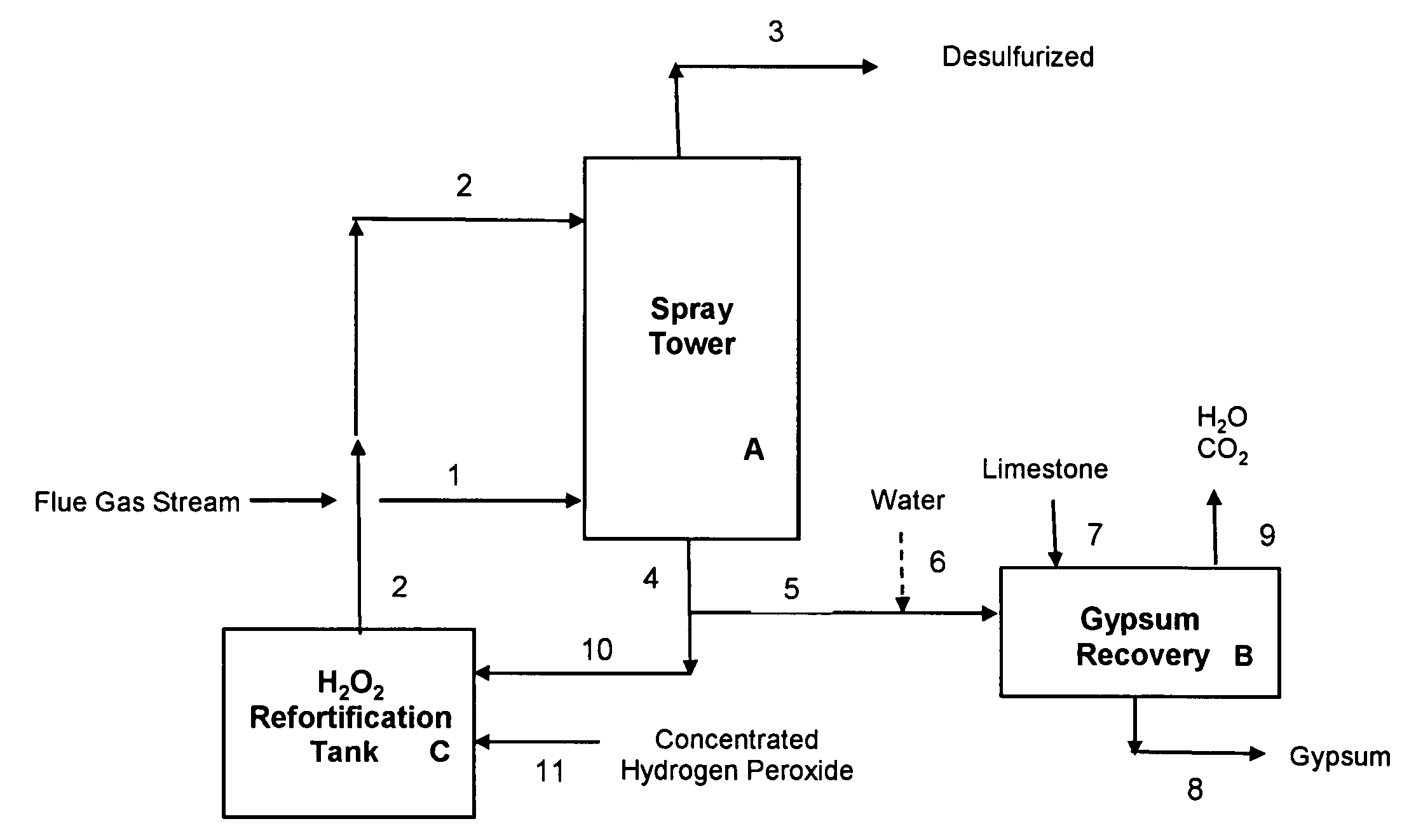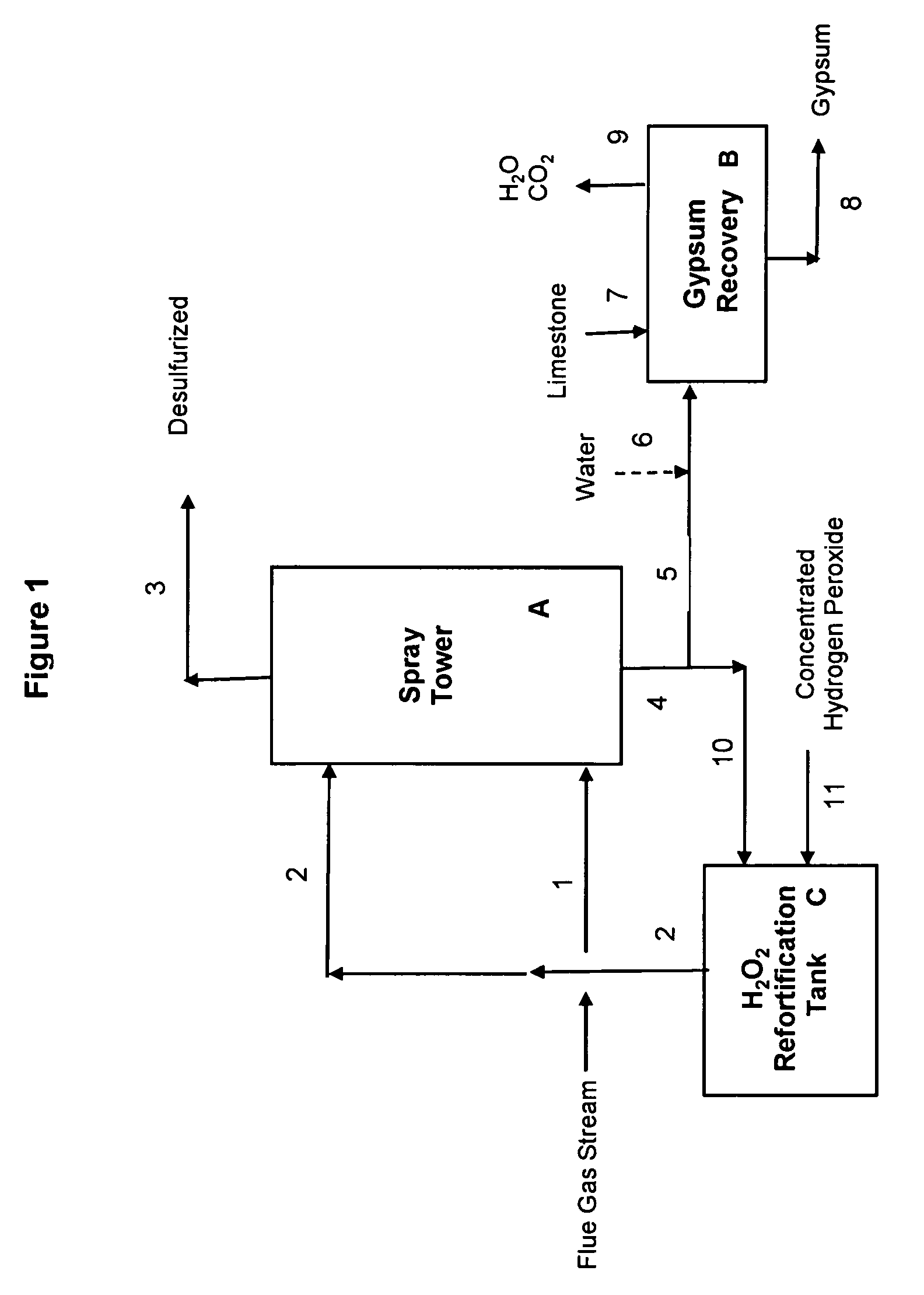Flue gas desulfurization process utilizing hydrogen peroxide
a technology of hydrogen peroxide and desulfurization process, which is applied in the direction of separation process, sulfur compound, dispersed particle separation, etc., can solve the problems of not meeting the complexity of unit operations, limiting the retrofitting of existing older small capacity power plants with desulfurization equipment, and not being able to dry or semi-dry scrubbing methods
- Summary
- Abstract
- Description
- Claims
- Application Information
AI Technical Summary
Benefits of technology
Problems solved by technology
Method used
Image
Examples
example 1
[0067]Example 1 illustrates a preferred embodiment of the present invention, using a concentrated sulfuric acid scrubber liquor stream also containing hydrogen peroxide, for desulfurization of a flue gas stream from a combustion boiler utilizing high sulfur coal. The desulfurization process of this Example 1 is operated in a manner that requires no input of external heat to the gypsum precipitation and recovery step. FIG. 1 illustrates a schematic flow diagram of this preferred embodiment; reference numerals and letters in the drawing are included in the process description which follows.
[0068]The flue gas composition in this Example 1 (and in subsequent Examples) is obtained from combustion of high sulfur coal containing 2.5 wt % sulfur, burned using 10% excess air. The flue gas composition is shown in Table 1.
[0069]
TABLE 1Flue Gas CompositionComponentConcentration: Wt BasisConcentration: Volume BasisSO20.49wt %0.22vol %SO349ppmw18ppmvH2O5.6wt %9.0vol %CO222.7wt %15.0vol %Other Gas...
example 2
[0081]Example 2 illustrates another preferred embodiment of the present invention, using a concentrated sulfuric acid scrubber liquor stream also containing hydrogen peroxide, for desulfurization of a flue gas stream from a combustion boiler utilizing high sulfur coal. The desulfurization process of this Example 2, like that of Example 1, is operated in a manner that requires no input of external heat to the gypsum precipitation and recovery step. In Example 2, the concentration of the make-up hydrogen peroxide 11 used to fortify the recirculating aqueous sulfuric acid stream 10 (see FIG. 1) is 36.7 wt % H2O2, as compared with 50 wt % H2O2 used in Example 1.
[0082]The flue gas stream used in Example 2 is identical to that of Example 1, but the recirculating aqueous sulfuric acid stream has a slightly different composition and flow rate. In the desulfurization step, the recirculating aqueous stream 2 is introduced into the spray tower A at a flow rate of 12,020 lb / hr and contains 49.9...
example 3
[0087]Example 3 illustrates yet another preferred embodiment of the present invention, using a concentrated sulfuric acid scrubber liquor stream also containing hydrogen peroxide, for desulfurization of a flue gas stream from a combustion boiler utilizing high sulfur coal. The desulfurization process of this Example 3, like that of Examples 1 & 2, is operated in a manner that requires no input of external heat to the gypsum precipitation and recovery step B, shown in FIG. 1. In Example 3, the concentration of the make-up hydrogen peroxide 11 used to fortify the recirculating aqueous sulfuric acid stream 10 (see FIG. 1) is again 36.7 wt % H2O2, as in Example 2.
[0088]The spray tower A in Example 3 is operated at a higher temperature than that assumed for Example 2, leading to higher water evaporation rates. In Example 2, no net water was evaporated during the desulfurization step in the spray tower A, i.e., the water vapor in the incoming flue gas stream 1 was identical to that presen...
PUM
| Property | Measurement | Unit |
|---|---|---|
| concentration | aaaaa | aaaaa |
| solubility | aaaaa | aaaaa |
| concentrations | aaaaa | aaaaa |
Abstract
Description
Claims
Application Information
 Login to View More
Login to View More - R&D
- Intellectual Property
- Life Sciences
- Materials
- Tech Scout
- Unparalleled Data Quality
- Higher Quality Content
- 60% Fewer Hallucinations
Browse by: Latest US Patents, China's latest patents, Technical Efficacy Thesaurus, Application Domain, Technology Topic, Popular Technical Reports.
© 2025 PatSnap. All rights reserved.Legal|Privacy policy|Modern Slavery Act Transparency Statement|Sitemap|About US| Contact US: help@patsnap.com


